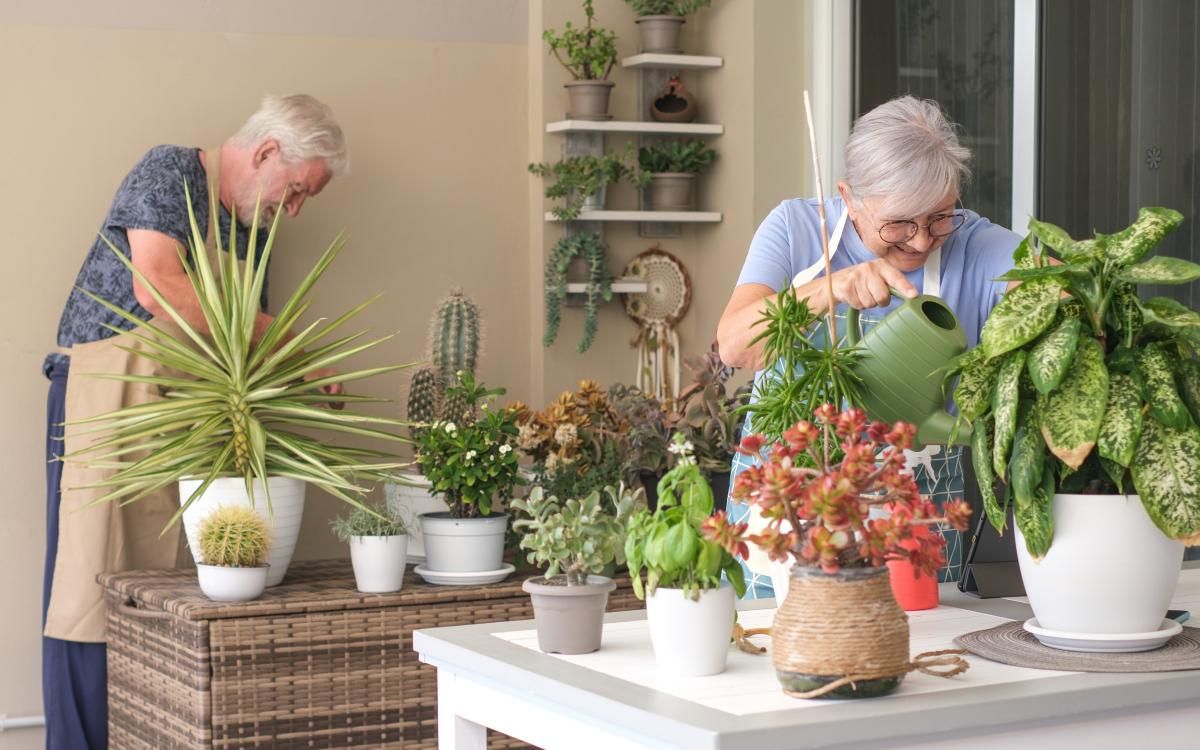As you age, your relationship with home and nature can become even more meaningful. The layout and design of your home play a pivotal role in ensuring safety, comfort, and emotional well-being. So, a thoughtfully designed space infused with personal touches can uplift your mood, enhance confidence, and support independence. To achieve this, you’ll need to learn how the aesthetics and functionality of the environment can enhance your overall well-being and enrich your daily retirement life.
How Layout Affects Mood and Energy
Thoughtfully designed layouts at home can significantly improve your emotional well-being. Studies show that a lack of a clean, organized structure can often lead to increased stress, hesitation, and fatigue. In contrast, a clean, well-arranged space can bring about several benefits, including better mental health. Additionally, when items are placed in the right place, it can improve confidence and comfort, making it easier to navigate your home spaces. You do not have to make drastic changes to see improvements; even small adjustments, like reorganizing a reading corner, can positively improve your daily mood and energy levels.
The Psychology of Color in Interior Spaces
The psychology of color has been studied for many decades. The human brain and vision perceive different wavelengths of light, which are then singled out as unique colors. This is why color can influence how you perceive your home. Therefore, choosing the right colors can make a home feel more welcoming and warm. For instance, soft greens and earthy browns can create grounding effects, while pale blues promote the feeling of relaxation. So, if you’re aiming for that perfect color balance, avoid harsh contrasts. Instead, pick warm, balanced tones, like those inspired by nature, to create a peaceful setting in your house.
Early Maintenance and Calm
Procrastinating by saying “I’ll do it later” rarely benefits anyone, especially when it comes to maintaining a home. So, if something is damaged, like a part of a window, it’s better to address the repair sooner rather than later to prevent the situation from worsening. This proactive approach can help keep repair and replacement costs to a minimum in the long run, particularly when monthly income becomes a crucial factor. And since money plays a significant role in influencing mental health, lower costs associated with future maintenance can be a stress reliever, helping you stay calm and happier.
How to Design a Comfortable Home
There are several ways to design spaces that prioritize calmness and comfort, especially for senior inhabitants.
Indoors
Choose Soothing Colors and Natural Materials
First things first, the colors and natural materials in your home can play a major role in creating a sense of calm and comfort. For instance, soft, calming colors can alter the emotional feel of a room, especially if you value warmth and relaxation. In the same way, incorporating natural materials like bamboo and light woods introduces a grounding presence, reducing sensory stress. Furthermore, adding plush throws, smooth upholstery, or woven rugs in spaces like living rooms can soften the environment, making the space more inviting and allowing for safe movement.
Incorporate Biophilic Design- Connecting with Nature
A Biophilic design can help you feel more at ease by bringing nature’s tranquility into your home. Adding natural wood furniture, indoor plants, or artwork inspired by landscapes can create a sense of harmony around your space. Having greenery in your living space is known to reduce stress and support emotional stability. Additionally, placing plants near windows or choosing nature-inspired color palettes can refresh your mind, making indoor spaces feel more airy, vibrant, and rejuvenating.
Use Daylight Effectively
After a certain age, you can become more sensitive to lighting conditions. Here’s where natural light can play a powerful role in balancing and uplifting your mood and energy levels. Increasing the amount of natural lighting in your home can help regulate sleep patterns, reduce fatigue, and create a warm, welcoming atmosphere. To maximize natural light, keep your windows clean and opt for light-filtering curtains. Additionally, arrange your furniture to avoid blocking of light, which can instantly change the overall feel and vibe of the room.
Outdoors
Create Zones for Meditation and Rest
Designing dedicated outdoor zones can help you create a space that exudes sense of calmness and reflection. Even a small corner with a comfortable chair, enough shade, and soft greenery can transform into a personal sanctuary. These spaces encourage mindfulness, gentle breathing, and moments of stillness, all of which promote emotional well-being. Even limited outdoor spaces like balconies or patios can be turned into peaceful retreats by adding comfy cushions, ambient lighting, and soothing natural home decor elements.
Install Soundscapes
Gentle soundscapes can transform outdoor spaces into calming environments. For instance, water features like small fountains provide a rhythmic, soothing flow that can relieve stress and mask harsh urban noises. Wind chimes can also add soft, melodic tones that promote a sense of peaceful atmosphere. Placing these elements in your house can help you listen to sounds that support meditative breathing. Positioning soundscapes near seating areas can enhance your overall sensory experience, making the garden or balcony a serene place to unwind.
Plant Fragrant, Low-Maintenance Flora
Fragrant, easy-to-care plants allow you to enjoy the outdoors without the hassle of creating a high-maintenance garden. Lavender, jasmine, basil, and rosemary plants release gentle scents that support relaxation and emotional balance. Moreover, these plants thrive with minimal attention, making them ideal for accessible garden spaces. Their subtle fragrances create a pleasant atmosphere, uplift mood, and contribute to creating comforting and calming environments.
Adapting for Comfort
Living Room – Clutter-Free, Slip-Proof Design Ideas
Your living room should focus on stability, comfort, and ease of movement. To prevent tripping hazards, keep the space free from clutter. Securing loose carpets with non-slip backing adds another layer of safety. Arrange your furniture in a systematic manner that creates wide, clear walkways for easy navigation. Also, make sure essential items like reading glasses, remote controls, and phones are within easy reach. Choose stable chairs with armrests to assist with safe sitting and standing positions.
Bedroom – Furniture Positioning and Night Lighting
Aging can affect your sleep patterns, and so it is important to take key steps to manage your sleep cycle. Your bedroom’s layout plays a crucial role in helping you navigate your space safely at night. For instance, installing night lights along the hallway and near your bed can help you move around the space without straining your eyes or risking a fall.
Most importantly, you must arrange your furniture practically and keep it minimal. Place bedside tables within reach, and ensure that your bed is at a comfortable height. Make sure you avoid furniture with low or sharp edges, as these can pose safety risks.
Creating a safe bedroom setup can help reduce stress, especially when you wake up at night to use the washroom. Studies show that lower stress levels can lead to better quality sleep.
Bathroom – Grab Bars, Seating, and Anti-Skid Flooring
The bathroom is one of the most accident-prone areas in your home. So, to enhance safety, consider installing sturdy grab bars near the toilet and inside the shower for added balance support. Additionally, using a shower chair or bath stool can help reduce fatigue, making bathing safer and more comfortable. Besides, consider placing anti-skid mats or installing textured tiles to prevent slipping on wet surfaces. By designing your bathroom thoughtfully, you can maintain your independent movements while minimizing risks.
Ensuring Safety Within A Budget
Creating a safe home space does not have to be expensive. Implementing a few thoughtful changes can help you enjoy comfort and security without digging a hole in your savings. Ultimately, ensuring your safety while staying within budget can positively influence your overall well-being.
Rearrange Instead of Replacing
Simply rearranging what you already own, like furniture or home decor pieces, can significantly impact your space, especially if you’re concerned about costs. Start by widening walkways by removing any objects that block movement. Place frequently used items, like keys, chargers, or prescriptions, at waist level to avoid bending or stretching. For larger furniture pieces, push them against the walls to enhance stability in your home.
Affordable Supportive Furniture
Budget-friendly supportive items can significantly enhance your comfort and safety. For instance, chair risers and back-support cushions are low-cost additions that can make your daily activities easier. Memory foam cushions can improve seating comfort, while lightweight stools in the kitchen or garden can provide stable support. Furthermore, simple upgrades like easy-grip handles, soft-close drawers, or battery-powered motion lights can help you improve safety while remaining budget-friendly. Consider getting a wheelchair, walker, or cane lights to make navigation at home or outside easier.
Easy DIY Safety Fixes
If you do not want to invest in expensive safety measures, you can opt for DIY options to save on costs and improve home safety. For instance, adding non-slip tape to stairs, securing loose wires with clips, or installing adhesive grab handles in vulnerable spots are easy tasks that require minimal tools. Additionally, placing rubber stoppers under carpets can prevent slips. Simple solutions, like installing brighter light bulbs or using stick-on corner guards, can also help reduce everyday risks.
Starting Small and Building Slowly
Do not rush to make changes at home. Start small and at a slow pace. This approach gives you ample time to adjust to the changes and ensures that you make quality changes at the right price.
- If you’re interested in gardening, begin with just one plant or a small area of your home. Also, choose low-maintenance plants like snake plants, money plants, or herbs.
- When cleaning out your wardrobe, trying to do everything at once can be overwhelming. Instead, set simple weekly goals, such as cleaning out one drawer at a time.
- Before adding new items to your home, consider whether you truly need them. Only bring in new things when you are comfortable managing what you already have.
- DIY projects can save you money and, at the same time, provide a fun experience. But, to avoid any strain, stick to lightweight tools. Using automatic tools can also help you get work done easily.
Ask For Help When Needed
Help is always available around you. All you need to do is ask.
Request Assistance for Heavy Lifting, Digging, or Climbing While Gardening
Handling Items like soil bags, large pots, and ladders can be risky, particularly as you get older. So, it’s important to ask for help with these tasks to avoid any injury, strain, or falls. Always know that you can still enjoy your home and garden safely without pushing your body too hard. Consider inviting your family members to assist you during the process; this can make tasks easier and make gardening a lot more fun.
Alternatively, you can join a senior gardening group too, which offers practical support like sharing tools, helping with planting, and providing advice. At the same time, these groups, like many others, create a sense of community building and enable social interactions.
Hire Professional Services
Cleaning, organizing, or renovating the house can be overwhelming and tiresome for many. So, look for affordable part-time help to maintain a comfortable home without wearing yourself out. You might also want to hire professionals for more complex tasks, like electrical or plumbing work. There are even experts available to handle gardening-related tasks, like lawn mowing.
Use Smart Home Devices
Technology can become a saving grace when you require assistance in every aspect of life. For instance, voice assistants can control lights, set reminders, and even replay previously set instructions. Furthermore, smart cameras and video doorbells are able to enhance security, while automated lights can reduce the need to walk across dark rooms to turn on a switch.
Conclusion
Creating a home that supports comfort, safety, and emotional wellness does not require major renovations or large expenses. With a few thoughtful adjustments—like choosing soothing colors, rearranging furniture, and adding supportive features—you can create a calming retreat. Additionally, seeking help when needed, utilizing smart tools, and maintaining your home regularly can help you enhance your independence and nurture peace of mind. It’s these small steps, and more, that can make everyday living safer, happier, and more fulfilling even after retirement.







There are no comments yet